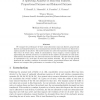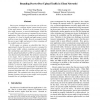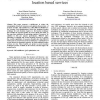RAID
2010
Springer
13 years 10 months ago
2010
Springer
Enterprise networks face a variety of threats including worms, viruses, and DDoS attacks. Development of effective defenses against these threats requires accurate inventories of n...
QUESTA
2006
14 years 11 days ago
2006
We compare the performance of three usual allocations (max-min fairness, proportional fairness and balanced fairness) in a communication network whose resources are shared by a ra...
JUCS
2008
14 years 12 days ago
2008
: This paper presents a novel market model for balancing communication bandwidth trade. The distinguishing characteristic of the model is that it assumes that market players can pl...
AICT
2008
IEEE
14 years 2 months ago
2008
IEEE
Currently many service providers offer their services using a private and proprietary hard- and software infrastructure. These infrastructures often share many similarities. Hence...
DSN
2007
IEEE
14 years 4 months ago
2007
IEEE
Peer-to-peer technique has now become one of the major techniques to exchange digital content between peers of the same interest. However, as the amount of peer-topeer traffic inc...
COMSWARE
2007
IEEE
14 years 4 months ago
2007
IEEE
This paper proposes a middleware to reduce the and consistency are usually poor since they depend on cell consumption of network resources and optimize the provision of size; GPS t...
ICNP
1998
IEEE
14 years 4 months ago
1998
IEEE
Network applications require a certain level of network performance for their proper operation. These individual guarantees can be provided if su cient amounts of network resource...
HPDC
2000
IEEE
14 years 4 months ago
2000
IEEE
Data-intensive applications in the Condor High Throughput Computing environment can place heavy demands on network resources for checkpointing and remote data access. We have deve...
ICN
2001
Springer
14 years 4 months ago
2001
Springer
New applications have been introduced to the today’s “best-effort” IP networks having different bandwidth and delay guarantee requirements. The IETF is currently focused on D...
ISCC
2002
IEEE
14 years 5 months ago
2002
IEEE
Network service provisioning involves the control of network resources through signaling, routing and management protocols that achieve Quality of Service and Traffic Engineering ...





